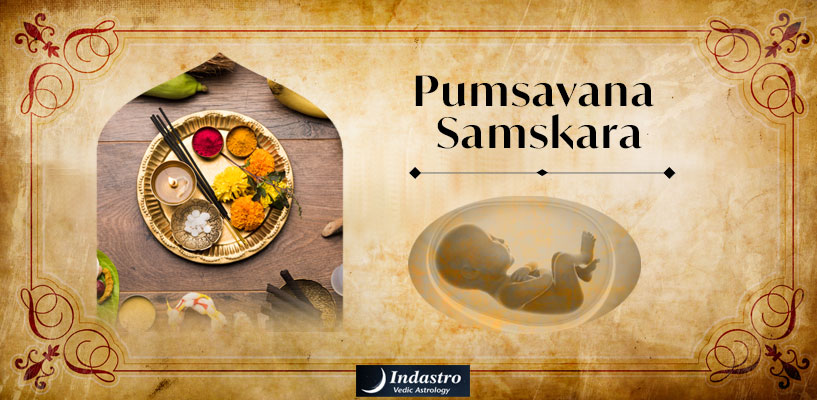Ritual for Mental Development of the Foetus (Simantonnayana Samskara)
This prenatal pregnancy ritual is conducted to encourage the mental development of the foetus. Herbal medicine administered to the mother through the nose is also part of this ritual, to ensure her good health as well as that of the child.
This ritual is performed for the mental development of the foetus. ‘Seemant’ means ‘brain’ and ‘utnayan’ means ‘development’. Simantonnayana is also known as ‘Simanta’ or ‘Simantakarana’ with the literal translation suggesting ‘parting the hair upwards’. It is primarily performed to destroy the defects of the ovum and foetus and to protect the foetus from micro-organisms and other negativity.
In this ritual, the husband and wife are seated together, surrounded by family and friends. The husband is then made to part the wife’s hair upwards, at least three times. This ritual has now evolved as a ‘baby shower’ ceremony and is also known as Godhbharai, Seemantham or Valakappu. The mother is dressed in traditional attire and jewelry, and the women in the family make her wear colourful bangles; the mother of the woman presents her with gold or silver bangle; and the priest chants a shielding mantra to protect both mother and child during the pregnancy.
When to perform this ritual?
- It is performed in the 6th or 8th month of pregnancy, aimed at the protection and health of the mother and unborn child.
How to perform this ritual?
- Sankalpa: The father invokes the supreme being by saying, ‘Destroy the negativity and demons, who are fond of meat and blood, that obstruct the growth of the foetus in the womb of my wife, let them be destroyed and disintegrated. May Devi Mahalakshmi destroy all the defects in the ovum and the womb with the Simantonnayana Samskara that I perform.’ The husband should perform this samskara in the 4th month.
- Oblation to Deities: In this samskara, oblation is offered to Matrudevata two times; Rakadevata two times; Vishnu three times; and to Prajapati once. Thereafter, the husband should take two bunches of the raw fruit of Audumbar (Holy fig tree), spikes of porcupine and three tender grass blades and, using the roots, part the woman’s hair three to four times while reciting, ‘ॠà¤à¥‚ः à¤à¥à¤µà¤ƒ सà¥à¤µà¤ƒ (Om Bhu Bhava Swaha)’.
Thereafter, the husband has to recite the following mantra:
Om dhata dadatu dashushe praci jivatum ukshitam
Ayam sumatim va jinivati idam dhatre idanna mama.
It translates as, ‘O God! By your grace we are blessed with strength and virtue! May the mother enjoy even greater health and vitality for the sake of the baby as it develops in the womb. We offer the oblation to you, O God, who blesses those who sustain others.’
The hair of the pregnant woman should be tied after this; and the priest should chant the Samaveda mantras.
- Nasya Karma: Nowadays people also perform Nasya Karma along with this ritual. It is the process where herbal medicines are mixed with milk and a few drops of this mixture are put in the nostrils of the mother. The nose is connected to the brain, therefore, this concoction is believed to boost favorable hormones in the mother to make the baby strong and healthy, and is also known to boost the immunity of the mother and child.
Science behind Simantonnayana Samskara
This samskara is performed to bless the foetus with a long and healthy life, to bless the mother to produce a healthy child with a sharp intellect and to prevent it from getting injured.
It is interesting to note that the task of the mother is similar to that of an architect since she can design and carve the personality of the child through the deep emotions which she undergoes during her pregnancy. The mother’s physical and emotional state plays a vital role in the growth of a child within the womb.
If a pregnant mother is unhappy, hormones like adrenaline and cortisol are secreted which produce sad neuropeptides in the mother’s body. These neuropeptides filter directly through the placenta, entering the foetal circulation up to the limbic system of the baby’s brain, which leads to lower electrical activities in the areas of joy, happiness and curiosity. The result of this is that the baby feels lonely and sad. If this continues for a longer duration, it will make the baby develop with low self-confidence and fear. Therefore, a pregnant mother has to maintain a positive mindset and avoid the transmission of negative messages to the baby in her womb.
Further, stress hormones activate the endocrine system and alter the distribution of blood flow in the foetus, thereby changing the character of the child’s physiology. This can make the baby hyperactive, premature and irritable, with a low birth weight. Whereas, when a mother is happy, peaceful and relaxed, her body secretes natural pleasure chemicals (endorphins) which infuse a state of happiness and calmness in the baby’s mind, ensuring the birth of a serene, calm, strong-minded, happy, and healthy baby.
Indastro top 10 Products
Translate











 Zodiac Sign and Numbers: Your favourite number revealing your personality!
Zodiac Sign and Numbers: Your favourite number revealing your personality!
 Ritual to Prevent Miscarriages (Pumsavana Samskara)
Ritual to Prevent Miscarriages (Pumsavana Samskara)
 When Taurus Turns Dark
When Taurus Turns Dark
 Astrological Significance of Feeding Stray Birds & Animals
Astrological Significance of Feeding Stray Birds & Animals
 Mother’s Day: Gifts you can give your mother as per her zodiac
Mother’s Day: Gifts you can give your mother as per her zodiac
